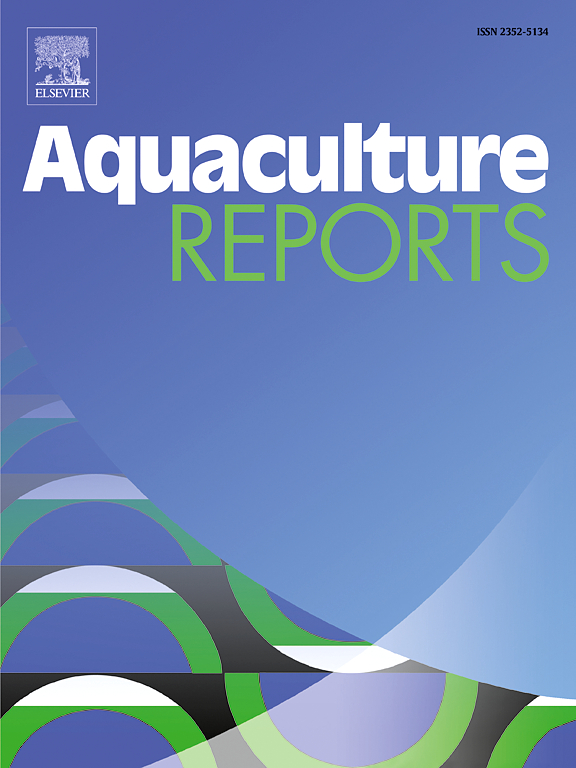Composition of California’s aquaculture industry and surveying its disease challenges and management strategies
IF 3.2
2区 农林科学
Q1 FISHERIES
引用次数: 0
Abstract
California (CA) aquaculture is best characterized by its diversity of production systems, cultured species, and final products. The industry comprises four major sectors (i.e., finfish, shellfish, macroalgae, and natural resource agency), which raise aquatic organisms for a variety of purposes, such as sustenance, conservation, recreation, and scientific research. In terms of commercial production value, California aquaculture contributes roughly 6 % to the total value of the U.S. aquaculture industry. The predominant forms of commercial aquaculture in CA are the production of finfish and shellfish for human consumption, which contribute 40.2 % and 30.0 %, respectively, to the total production value of the industry. Other forms of commercial aquaculture in CA include the production of sportfish species for recreational fishing, and other seafood products like caviar and macroalgae. Natural resource agencies, such as the California Department of Fish and Wildlife (CDFW), are also significant aquaculture producers that raise salmonids for conservation and recreation purposes. The diversity within CA aquaculture requires an equally diverse set of disease management strategies that address the specific needs of each sector. A recent survey on aquatic animal health indicates that California finfish and shellfish facility managers are aware of disease challenges and use a preventative approach to reduce the likelihood of disease outbreaks. Our survey results suggest that when disease is detected, non-prescription antimicrobial products (i.e., hydrogen peroxide) are used most frequently for disease treatment (71 % commercial, 17 % commercial shellfish, 86 % CDFW), while prescription antibiotics are only utilized following veterinary review and approval (18 % commercial finfish, 0 % commercial shellfish, 71 % CDFW). Biosecurity and disease-response protocols are also important components of disease management, and their standardization across each sector will enhance the disease prevention capabilities of the aquaculture industry.
加州水产养殖业的组成及其疾病挑战和管理策略的调查
加州(CA)水产养殖的最大特点是其生产系统、养殖物种和最终产品的多样性。该产业包括四个主要部门(即鳍鱼、贝类、大型藻类和自然资源机构),它们饲养水生生物用于各种目的,如维持、保护、娱乐和科学研究。就商业产值而言,加州水产养殖对美国水产养殖业总价值的贡献约为6% %。加州商业水产养殖的主要形式是生产供人类消费的鳍鱼和贝类,它们分别占该产业总产值的40.2% %和30.0% %。加州其他形式的商业水产养殖包括生产休闲钓鱼用的运动鱼类,以及鱼子酱和大型藻类等其他海产品。自然资源机构,如加州鱼类和野生动物部(CDFW),也是重要的水产养殖生产者,以保护和娱乐为目的饲养鲑科鱼。CA水产养殖内部的多样性要求一套同样多样化的疾病管理战略,以满足每个部门的具体需求。最近一项关于水生动物健康的调查表明,加州鳍鱼和贝类设施的管理人员意识到疾病的挑战,并采用预防性方法来减少疾病爆发的可能性。我们的调查结果表明,当检测到疾病时,非处方抗菌产品(即过氧化氢)最常用于疾病治疗(71% %商业,17% %商业贝类,86% % CDFW),而处方抗生素仅在兽医审查和批准后使用(18% %商业鳍鱼,0% %商业贝类,71% % CDFW)。生物安全和疾病应对方案也是疾病管理的重要组成部分,它们在各个部门的标准化将增强水产养殖业的疾病预防能力。
本文章由计算机程序翻译,如有差异,请以英文原文为准。
求助全文
约1分钟内获得全文
求助全文
来源期刊

Aquaculture Reports
Agricultural and Biological Sciences-Animal Science and Zoology
CiteScore
5.90
自引率
8.10%
发文量
469
审稿时长
77 days
期刊介绍:
Aquaculture Reports will publish original research papers and reviews documenting outstanding science with a regional context and focus, answering the need for high quality information on novel species, systems and regions in emerging areas of aquaculture research and development, such as integrated multi-trophic aquaculture, urban aquaculture, ornamental, unfed aquaculture, offshore aquaculture and others. Papers having industry research as priority and encompassing product development research or current industry practice are encouraged.
 求助内容:
求助内容: 应助结果提醒方式:
应助结果提醒方式:


